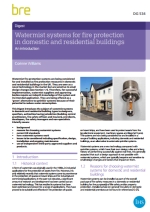Watermist systems for fire protection in domestic and residential buildings DG 534
BRE (Building Research Establishment) is an independent, research-based consultancy, testing and training organisation, operating in the built environment and associated industries.
Watermist systems for fire protection in domestic and residential buildings: An introduction (DG 534) was published by BRE on 10 September 2014. It was written by Corinne Williams.
A form of watermist was first used for the protection of assets from fire in industrial applications in the 1930’s. More recently they have been used for the protection of spaces on board ships and for industrial and commercial applications. Watermist fire protection systems are now being considered for installation as fire protection measures in domestic and residential buildings in the UK. They can be considered a ’green’ alternative to automatic sprinkler systems because of their potential to reduce water consumption, although they are seen as a novel technology in the market.
Watermist fire protection systems are sensitive to small design changes and so successful implementation requires in-depth knowledge of the system and its intended application from watermist suppliers and approving bodies.
This 12 page digest provides an introduction to watermist systems in domestic and residential buildings for designers, specifiers, authorities such as building control bodies, fire safety officers and insurers, clients, developers, fire safety managers and non-specialists. It covers the general background, reasons for choosing watermist systems, current UK standards, how watermist systems work, issues to be considered during specification, design, installation and ongoing maintenance, the use of independent third-party approved suppliers, and products.
The contents of the digest include:
- Introduction.
- Description of domestic and residential watermist systems and how they work.
- Standards.
- System fire performance tests.
- Planning and specification.
- Design, installation and commissioning.
- Ongoing maintenance, system continuity and documentation.
- Alternative suppression systems.
- Use of independent third-party approved suppliers and products.
- Conclusions.
- References.
- Further information.
[edit] Related articles on Designing Buildings Wiki
- Automatic fire sprinkler systems: A good practice guide.
- BRE articles on Designing Buildings Wiki.
- BRE Buzz articles on Designing Buildings Wiki.
- BRE Buzz.
- Building Research Establishment.
- Design benefits of automatic sprinkler systems granted under approved document B.
- Evaluation of cooling effects: outdoor watermist fan.
- Fire in buildings.
- Fire protection engineering.
- Fire safety design.
- Making the case for sprinklers and dispelling myths.
- Personal protection watermist systems in the homes of vulnerable people.
- Sprinkler systems explained: A guide to sprinkler installation standards and rules.
- Sprinkler.
- The impact of automatic sprinklers on building design.
Featured articles and news
Latest Build UK Building Safety Regime explainer published
Key elements in one short, now updated document.
UKGBC launch the UK Climate Resilience Roadmap
First guidance of its kind on direct climate impacts for the built environment and how it can adapt.
CLC Health, Safety and Wellbeing Strategy 2025
Launched by the Minister for Industry to look at fatalities on site, improving mental health and other issues.
One of the most impressive Victorian architects. Book review.
Common Assessment Standard now with building safety
New CAS update now includes mandatory building safety questions.
RTPI leader to become new CIOB Chief Executive Officer
Dr Victoria Hills MRTPI, FICE to take over after Caroline Gumble’s departure.
Social and affordable housing, a long term plan for delivery
The “Delivering a Decade of Renewal for Social and Affordable Housing” strategy sets out future path.
A change to adoptive architecture
Effects of global weather warming on architectural detailing, material choice and human interaction.
The proposed publicly owned and backed subsidiary of Homes England, to facilitate new homes.
How big is the problem and what can we do to mitigate the effects?
Overheating guidance and tools for building designers
A number of cool guides to help with the heat.
The UK's Modern Industrial Strategy: A 10 year plan
Previous consultation criticism, current key elements and general support with some persisting reservations.
Building Safety Regulator reforms
New roles, new staff and a new fast track service pave the way for a single construction regulator.
Architectural Technologist CPDs and Communications
CIAT CPD… and how you can do it!
Cooling centres and cool spaces
Managing extreme heat in cities by directing the public to places for heat stress relief and water sources.
Winter gardens: A brief history and warm variations
Extending the season with glass in different forms and terms.
Restoring Great Yarmouth's Winter Gardens
Transforming one of the least sustainable constructions imaginable.
























